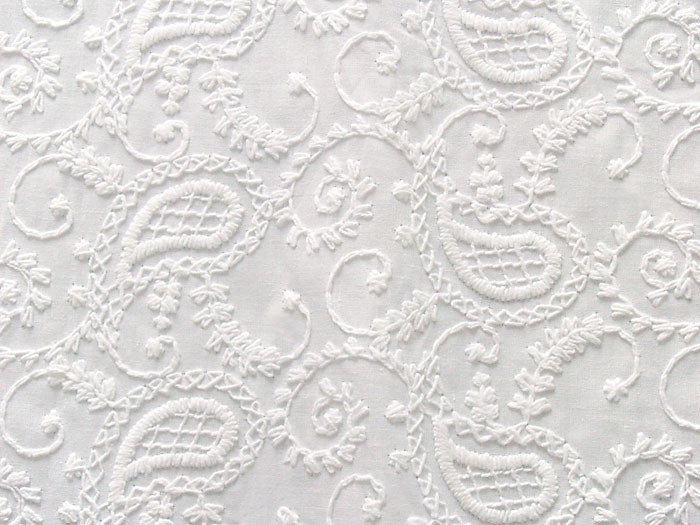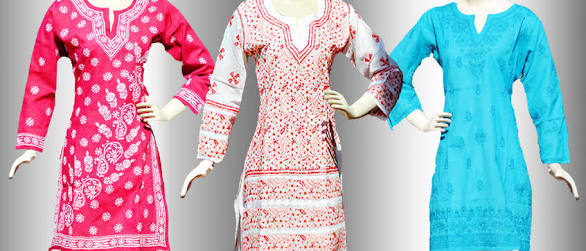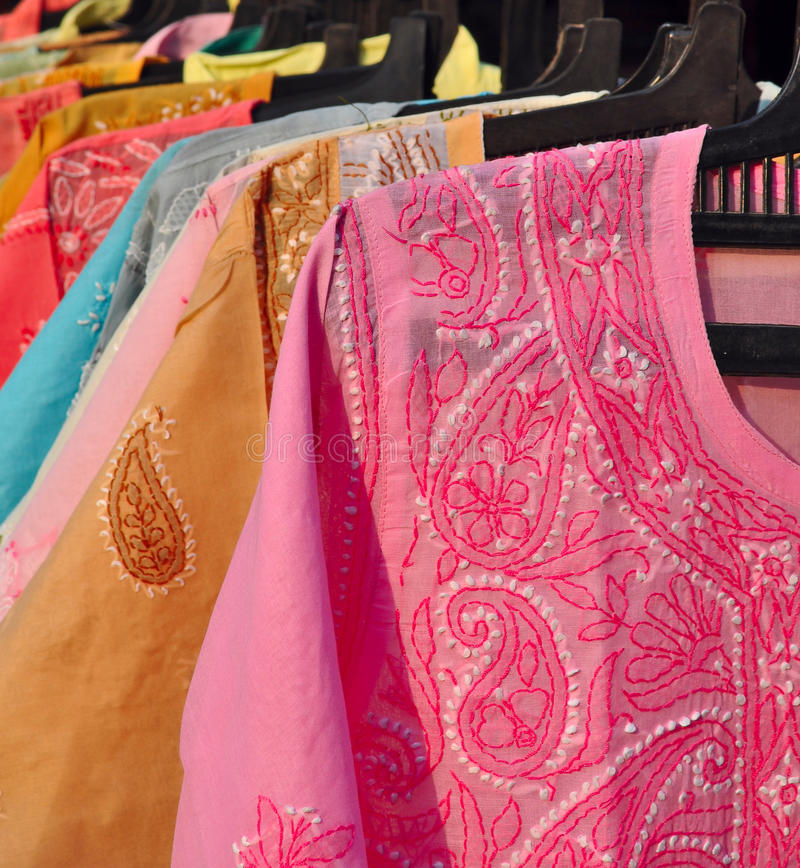Welcome to my city Lucknow, where Chicken is not only eaten with great delight, but also worn (Chikan) with equal charms. Lucknawi Chikan is the major craft work of Lucknow. The art or technique is known as Chikankari. The word ‘Chikan’ literally means “embroidery” and is derived from the Persian word ‘chikaan’ meaning drapery. The art is unique in itself because it incorporates ion itself approximately 36 different stitching techniques. Chikankari can be synonymous with ‘white on white’ because mostly chikankaari is done using white thread on white fabric. But nowadays, due to changing and evolving fashion trends, it is being done on various coloured cloths.

History of Chikankaari
Chikan work is almost 400 years old art. Some historians believe it’s origin is from 3rd century AD, during the reign of Chandragupta Maurya, as indicated by Megasthenes’ account. Another commonly believed theory is about the contribution of Mughal king Jehangir’s wife Noor Jahan to the craft. In that era, Chikankaari was limited only to white muslin cloth, owing to the warm, humid climate of India. After the fall of Mughal empire, the credit of restoring Chikankaari to its former glory goes to the then Governor of Oudh- Burhan-Ul-Malik, which is why Lucknow is the centre of Chikankaari.
Why is Chikankaari essentially in floral designs?
The Mughals were Persian descendants, so Persian influence over Chikankaari is obvious. This is why, Chikankaari is mostly found in floral designs. The styles of the flowers may vary, and sometimes, stems, leaves, etc are also there to increase the continuity of the pattern.

How is it made?
The making procedure can be roughly broken into 3 stages. Firstly the design is block printed on the cloth of choice. The cloth is stitched into the garment it will form- a suit, kurta, frock, etc. block printing is done using multiple wooden blocks of wanted designs and washable blue ink on the fabric. Next is embroidery in which the blue inked patterns are traced by needle work. The most special feature of this embroidery is that as many as 36 types of stitches are used in this phase. Depending on the pattern intricacy and size of the piece, the embroidery process alone can take up to 10 days to complete. Next, the fabric is soaked in water to wash away the blue ink outlines and then it is starched to obtain the right stiffness depending upon the fabric.

Types of stitches:
- Tepchi
- Bakhiya
- Hool
- Zanzeera
- Rahet
- Banarsi
- Khatau
- Phanda
- Murri
- Jali
- Turpai
- Darzdari
- Pehchani
- Bijli
- Ghaspatti
- Makra
- Kauri
- Hathkadi
- Banjkali
- Sazi
- Karan
- Kapkapi
- Madrazi
- Bubul-chasm
- Taj Mahal
- Kangan
- Dhania patti
- Rozan
- Meharki
- Chanapatti
- Baalda
- Jora
- Keel kangan
- Bulbul
- Sidhaul
Type of cloth used:
The fabrics used must be soft as the entire embroidery is hand stitched. Silk, chiffon, georgette, net, voile, kota, doriya, cotton, organza, muslin and faux fabrics are, therefore, best suited.
Type of garments made:
Chikan garments are made for both sexes and for all age groups. They include everything from long and short kurtas, tunics, sarees, Anarkalis palazzos, t-shirts, capri pants and even accessories such as shoes, bags, belts, lamp shades, table cloths, cusion covers, etc.
Undoubtedly, the sheer variety of Lucknow Chikan work today is more bountiful than ever before. It is in great demand in generally urban masses and celebrities in Bollywood and Hollywood alike. Who can forget the famous scene in the song “Rangrez” in the movie “Tanu weds Manu” featuring Kangana Ranaut. The charms of Chikankaari have been beautifully potrayed on the 70 mm screen many a times. The Geographical Indication Registry accorded Lucknow Chikan the GI status in December 2008.

Sweat of the artisans!
It won’t be righteous to talk about Lucknow and Chikankaari, in such details and not about the artisans who shed their sweat making it. Chikankaari is a highly skilled work and is quite time consuming, because it is hand stitched. So, it requires genius of a skilled artist, for which training alone can take up to 20 years. Two of the most renowned Chikan artists are Ustad Faiyaaz Khan and Hasan Mirza Saheb.
Image source: Google


Love this embroidery! My mum is obsessed with Chikan work!!!
LikeLiked by 3 people
Aha its really beautiful! No one can resist the temptation 😊
LikeLiked by 2 people
I had a gorgeous white Shalwar kamees that was Chikan work and I loved it! I have Chikan kurtis too that I wear in the summer!
LikeLiked by 2 people
Same here. I loved the comfort and elegance they bring in summers. Plus they never go off trend.
LikeLiked by 1 person
😁
LikeLiked by 3 people
A very entertaining and informative post!
LikeLiked by 3 people
Thanks for reading!
LikeLiked by 2 people
Thank you for enlightening us with so much knowledge about this wonderful art!
LikeLiked by 2 people
Thanks for reading it earnestly!
LikeLiked by 1 person
Beautiful!
LikeLiked by 3 people
Thanks a lot 😊
LikeLiked by 1 person
Wow it is so beautiful
LikeLiked by 3 people
It really is!
Thanks for reading 😊
LikeLike
Ooh thanks for showing such a wonderful art with this amazing beautiful designs
LikeLiked by 1 person
You’re most welcome 😊
LikeLike
I loved the patterns so much
LikeLiked by 1 person
Great work
LikeLiked by 2 people
Thanks a lot 😊
LikeLiked by 1 person
WOW great article 🙂 very informative 🙂 I love chikan work 🙂 infact I recently bought two chikan kurtas from ADA studio, Lucknow 🙂 The sheer elegance and beauty of this handcraft skill is marvelous 🙂 It can never get out of fashion 🙂
LikeLiked by 3 people
Thanks for reading 😊
And yes, it never goes out of trend
LikeLike
Nice write up, this is a dream world of wonderful art work, talent, imaginations. The entire sales and business sector dominated by group of people who are totally exploiting poor and uneducated skilled work force. I was there couple of times and visited the places how hard work behind these beautiful designs. How big groups make big money selling these clothes all over and the working community left behind with poverty and struggle and more exploitation. The so called many past govt s including present rulers never care and build this industry to get fame world wide but every day they wear same best designed dresses and show off in public. Also very hard to educate the crowd in this line up to encourage to export as they have no money and facilities.
Hope you will continue the article with various parts of industry and people involved to blog the best to show the grievances parts so govt and industry can take it seriously to build this industry to super million dollars trade and the lives of people improve and next generations get wide range of education health and smiles to all who involved.
Also if any one want to export this designs our doors are open to place orders. We can support a cause at step one.
Wonderful to read your article. Hope you can further help people to enlighten them for bigger growth in lower line up.
Cheers Himanshi, appreciate your time.
LikeLiked by 4 people
Thanks for sharing your thoughts. It made me rethink about my city and it’s ancient art again. I’ll try to come up with a blog post on the same. Thanks again 😊
LikeLiked by 1 person
Glad… the story behind beautiful things of the city will help those hard working families. I am sure your new post will certainly help those some where. All the best. Cheers.
LikeLiked by 2 people
Definitely. Thanks for the wonderful idea!
LikeLike
Good luck and all the best. Have a nice day
LikeLiked by 1 person
Delighted to know that you also hails from Lucknow☺
Lucknow has been better known for its embroidery called ‘chikankaari’ .
It’s appaling that despite greater push by various stakeholders, the art is rapidly losing its charisma and ebulience.
Hope with the course of time this remarkable skill and art would rejuvenate.
LikeLiked by 3 people
Especially after it was taxed, the artisans had to suffer. But the craze that the people have for it, I don’t think that it would ever become outcast. Nevertheless, it has lost its original charm.
Thanks for reading and sharing your thoughts.
LikeLiked by 1 person
Indeed my pleasure.
LikeLiked by 1 person
That’s so amazing to know about chikankari in so much detail. I always like it because of its elegance and sophistication.. nicely composed ✌️
LikeLiked by 3 people
Thanks a lot for reading. Glad you liked it 😊
LikeLike
Oh so many different stitches wow .I love my chicken saree
LikeLiked by 3 people
Oh yeah! I love my chikan kurta too
Thanks for reading
LikeLiked by 1 person
I love chikankari clothes and so good to know about all the details and hardwork that goes into creating it , very informative post!
LikeLiked by 2 people
Thanks for reading 😊
LikeLiked by 1 person
Exquisite. My word!!! Thank You for sharing. Cheers! 🙂
LikeLiked by 3 people
Oh thank you so much for reading 😊
LikeLiked by 1 person
My pleasure!!! 🙂
LikeLiked by 1 person
This is an amazing post…… You literally shared every possible detail….. I just love chikankari work and I am really happy to know that you also like it…… 🤗 Thanks for sharing this post 👍👍
LikeLiked by 3 people
Thanks for reading it earnestly. Well I have to love it, it’s the art of my city!
LikeLiked by 1 person
Yeah our city is truly amazing 😍
LikeLiked by 1 person
So it is! Hope to meet you sometime.
LikeLiked by 1 person
Sure 👍😊
LikeLiked by 1 person
Beautiful. I would never have the patience to work on something so intricate.
LikeLiked by 3 people
Thanks a lot. Yes, it requires a lot of patience to complete the pattern so intricately. That’s why only a few people have mastered the art.
LikeLiked by 1 person
I’ve often seen those garments in movies and TV shows, but I never knew what they were called. Thanks for sharing the info and the cultural insight!
LikeLiked by 3 people
Thanks for reading 😊
LikeLiked by 1 person
very interesting! thanks for sharing. 🙂
LikeLiked by 3 people
Thanks for reading 😊
LikeLiked by 1 person
Wow! So Beautiful. Thank you for introducing me to this!
LikeLiked by 3 people
Thanks for reading and appreciating. Chikan work is really adorable!
LikeLiked by 1 person
I wish my wardrobe had pieces like this. Such a beautiful art form.
LikeLiked by 3 people
Well you can order them online.
LikeLiked by 1 person
I might just do that come Spring. 🙂
LikeLiked by 1 person
Oh yes. They’re summer stuff
LikeLiked by 1 person
Yeah, and I want to lose weight for the Summer so I can look decent in them. 🙂
LikeLiked by 2 people
So get started soon😊
LikeLiked by 1 person
Already ahead of you. 🙂 Thanks!
LikeLiked by 1 person
😊
LikeLiked by 1 person
You can rock them at any size mam, I’m sure you will look gorgeous!!
LikeLiked by 3 people
That is equally true!
LikeLiked by 1 person
Thanks. 🙂
LikeLiked by 3 people
Oh I love chikankari. Especially during the Summers, there’s nothing better than a mull kurta with some light chikankari on it..
LikeLiked by 3 people
Yes. It looks very beautiful and is extremely comfortable 😊
LikeLiked by 1 person
Beautiful! I live in Puerto Vallarta Mexico, however, my favorite store imports this type of embroidery and the softest cotton from India.
LikeLiked by 3 people
That’s great to know. It means I don’t have to tell you how beautiful they look 😊
LikeLike
Truly beautiful designs and clothing! Will certainly purchase when visiting your city! God bless! 💕
LikeLiked by 4 people
Thanks a lot. Yes, it is very very beautiful. I’m sure you’ll love it😊
LikeLiked by 1 person
You’re welcome much!! Indeed!! Of course I will✨💕
LikeLiked by 1 person
😊
LikeLiked by 1 person
I’d love to visit Lucknow someday and experience how the Chikan work is done.
LikeLiked by 2 people
Good to know that! Do visit my city😊
Thanks a lot for reading 😊
LikeLiked by 1 person
Love the way u wrote chicken is eaten and worn too👏🏻
LikeLiked by 3 people
Oh I heard it once… I guess on a radio station
LikeLiked by 1 person
Very nice post and thanks for the meaningful informations. A delight for a fashionista like me. My hubby recently bought me a beautiful B&W piece from one of his trip to India. Love it. Can’t wait to wear it and show it on my blog.
LikeLiked by 3 people
Great work… a whole overview. even I have been living in Lucknow for long time but didn’t know too much about Chikan history
LikeLiked by 3 people
Thanks a lot. Good that now you know!
LikeLiked by 1 person
So beatiful
LikeLiked by 2 people
Thanks a lot 😊
LikeLike
https://cartoonartindore.wordpress.com
LikeLike
Oh mate What would I say? Really… really loved the articleThank you so much!
LikeLike